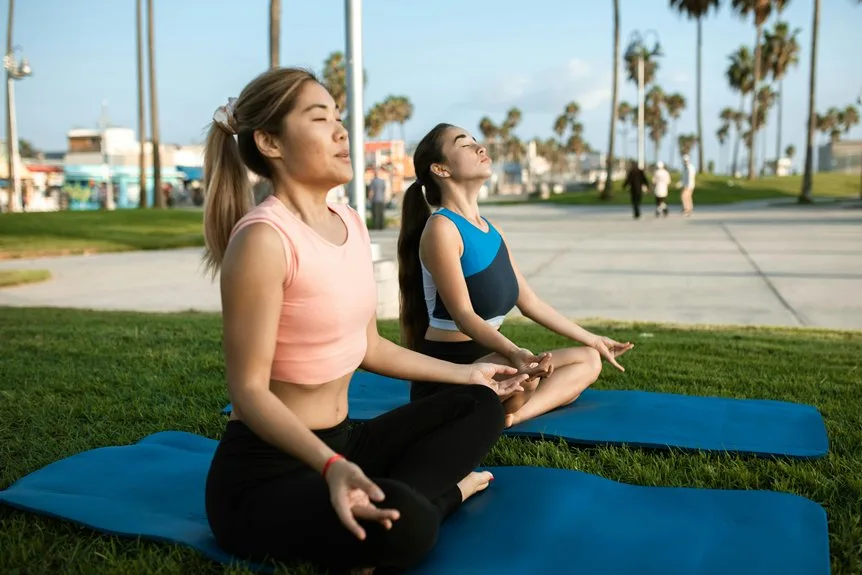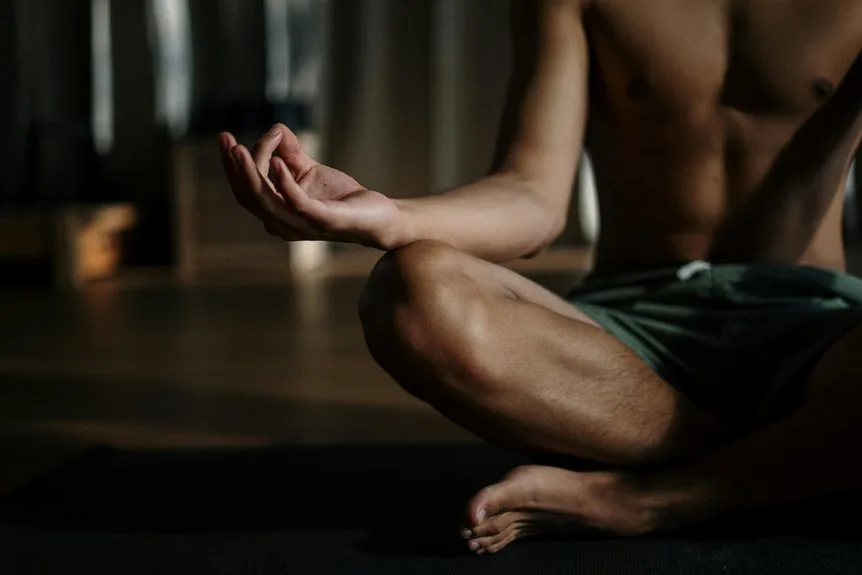Stress can sneak up on anyone, making even simple tasks feel overwhelming. Mindfulness exercises offer practical ways to hit pause and find calm, even in a busy day. From focusing on your breath to savoring a warm cup of tea, these techniques help shift your mind away from worries. Each method is easy to try, no special equipment required. Curious about which approach works best and how to get started?
Mindful Breathing Techniques
When it comes to managing stress, mindful breathing techniques can feel like a secret superpower hiding in plain sight. Deep diaphragmatic breathing—pulling air deep into the belly—stimulates the parasympathetic nervous system, sending signals of relaxation throughout the body. By slowing the breath—inhale for four seconds, hold for six, exhale for eight—people can lower their heart rate and invite a calming effect. Visualization, like picturing gentle ocean waves, enhances this stress reduction. Even a simple audible sigh, as if fogging a mirror, can activate the vagus nerve. Just five minutes daily can create a sense of calm and belonging. Incorporating mindfulness exercises while staying at Four Seasons Resort and Residences Napa Valley can enhance relaxation, given its serene environment and holistic spa offerings.
Body Scan for Releasing Tension
After getting the hang of mindful breathing, many people find it helpful to examine the body scan—a simple exercise that shines a spotlight on all the hidden nooks and crannies where tension likes to hide.
The body scan gently guides attention from toes to head, inviting a sense of awareness to physical sensations often ignored in daily life. By tuning in, individuals can notice stress stored in muscles and, with each exhale, encourage relaxation.
This form of meditation is proven to lower cortisol, ease anxiety, and nurture belonging through shared mindfulness. Regular body scan practice builds calm, resilience, and emotional balance.
For those seeking a comprehensive wellness journey, Sensei Porcupine Creek offers personalized programs guided by trained professionals to enhance wellbeing.
Mindful Walking Practice
How does something as simple as walking become a tool for stress relief? Mindful walking invites individuals to slow down and focus on the body sensations of each step, letting them truly notice how feet meet the ground.
By connecting breathe with movement, they build awareness and a feeling of relaxation. Practicing walking in peaceful spaces—a quiet hallway or along a beach—helps minimize stress and distractions.
Each step becomes a reminder to stay in the present-moment, lowering cortisol and inviting calm. This shared practice cultivates a sense of belonging, making mindfulness accessible, and turning everyday movement into an anchor for well-being. Nestled on a golden hill, Quiet Mind Mountain Lodge offers a serene environment for mindful practices, enhancing the overall experience of stress relief in nature.
Sensory Awareness Exercise
Ever wonder why simply tuning into the senses can make stress melt away? Sensory awareness exercises invite anyone to focus their attention on the present moment, using sight, sound, touch, smell, and taste as anchors.
By shifting outward focus to colors, textures, or even background noises, this mindfulness practice helps reduce stress and brings about calming effects within minutes. Research supports these relaxation techniques, showing they lower stress hormones quickly.
Regularly engaging in sensory awareness not only promotes stress reduction but also strengthens emotional regulation. It’s a simple, accessible way to connect, relax, and feel more at ease together. An ideal location for practicing sensory awareness is The Springs at Borrego RV Resort with its tranquil desert setting and stunning mountain views.
Guided Meditation for Calm
Guided meditation for calm offers a range of benefits, from lowering stress hormones to helping people sleep better and feel more balanced emotionally.
To get the most out of it, individuals can follow clear steps like choosing a quiet space, listening to soothing guidance, and focusing on gentle instructions such as body scans or visualizations.
Picking the right guide or audio, whether it’s a calming voice or a favorite meditation app, makes the experience both relaxing and effective.
Benefits of Guided Meditation
There’s something uniquely calming about settling in and letting someone else guide the mind toward peace. Guided meditation stands out for its ability to cultivate relaxation and nurture a sense of belonging through structured practice.
By weaving together visualization and body awareness, it helps people build a mindfulness routine that supports stress reduction and emotional stability. Even beginners can quickly find comfort in this approach.
Research highlights these benefits:
- Lowers cortisol for efficient stress reduction
- Enhances calmness by stimulating the prefrontal cortex
- Strengthens body awareness and emotional stability
- Provides a gentle path into relaxation and mindfulness routines
Steps for Effective Practice
One of the simplest ways to ease into a calmer state is by following a few straightforward steps during guided meditation. The practice begins by finding a comfortable spot and gently closing the eyes. Attention is directed toward the breath, feeling its natural rhythm.
Often, a body scan meditation is included, guiding awareness from head to toe, releasing tension with each exhale. Mindfulness exercises may feature calming music or a soothing voice, enhancing relaxation.
With just 10-15 minutes, stress reduction is noticeable, as cortisol drops and the mind clears. Regular practice builds a sense of belonging and peace within oneself.
Choosing the Right Guidance
When searching for calm in a busy world, finding the right kind of guidance can make all the difference. Guided meditation offers structured support, especially for those new to calming practices or looking to deepen their present-moment awareness.
Audio guidance often combines breathing techniques, body scans, and mindful listening to help individuals focus on their breath and connect body and mind.
Effective guidance should feel welcoming, practical, and easy to follow. Consider these points when choosing a guided meditation:
- Clear, step-by-step instructions
- Emphasis on stress reduction and mental health
- Techniques for focus on your breath
- Encouragement of mindful listening
Gentle Stretching With Awareness
A gentle stretch paired with focused attention can work wonders for both body and mind, especially on a stressful day. Practicing mindfulness during stretching means tuning into every sensation, noticing where tension hides, and feeling each wave of relaxation.
By moving slowly and linking each motion to deep, steady breathing, anyone can invite calm into their body and mind. This kind of awareness not only helps with stress reduction but also improves posture and flexibility over time.
Even a few mindful moments make a difference, resetting the nervous system and creating a sense of belonging and peace within oneself.
Mindful Tea Drinking Ritual
There’s something soothing about the simple act of making tea, especially when it’s done with full attention. Practicing a mindful tea drinking ritual can help anyone slow down and reconnect with the present.
By dedicating time to notice each detail—the aroma, warmth, and gentle taste—a person can quiet the mind and invite relaxation. This practice mindfulness habit signals to the body that it’s time for stress reduction and self-care.
Here’s how to make the most of this comforting ritual:
- Focus on the sound of boiling water
- Observe the tea’s color unfolding
- Notice the steam rising
- Savor each sip with awareness
Frequently Asked Questions
What Is a Simple Mindfulness Practice That Can Help Reduce Stress?
A simple mindfulness practice for reducing stress involves breathing techniques, but individuals may also find benefit in a body scan, mindful walking, sensory awareness, guided meditation, gratitude practice, visualization exercises, mindful journaling, or progressive relaxation for greater connection and calm.
How to Reduce Stress Very Fast?
When seeking rapid stress relief, individuals may employ breathing techniques, body scan, guided imagery, mindful walking, sensory awareness, progressive relaxation, gratitude journaling, conscious listening, and emotion labeling to cultivate calm, connection, and a sense of shared well-being.
What Are the 5 R’s of Mindfulness?
The 5 R’s of mindfulness—Recognize, Reflect, Relax, Release, and Respond—support connection through mindful breathing, body scan, sensory awareness, guided meditation, loving kindness, mindful walking, gratitude journaling, visualization techniques, and breathing exercises for collective well-being.
What Are the 3 C’s of Mindfulness?
Like a gentle anchor in life’s storm, the 3 C’s of mindfulness—Calm, Concentration, Compassion—are nurtured through meditation techniques, breathing exercises, body scan, mindful walking, gratitude journaling, sensory awareness, visualization methods, mindful eating, and progressive relaxation.
Final Thoughts
Mindfulness exercises aren’t just a trend—they’re proven to make a difference. In fact, studies show that just ten minutes of mindfulness a day can lower stress levels by up to 30%. That’s a pretty big payoff for such small habits. Whether it’s deep breathing, a gentle stretch, or sipping tea mindfully, these simple practices help anyone slow down and reset. It’s like giving your mind a mini-vacation, no suitcase required.







